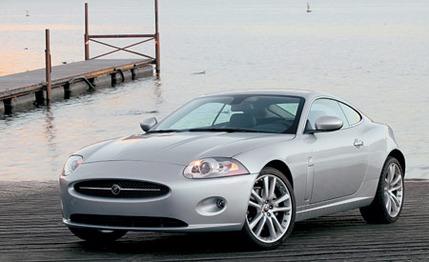
 First Drive Review
First Drive Review
Once a breakthrough has been made, it seems so simple. "Why didn't we think of that?" ask the competitors.
A six-speed automatic that makes eye-blink-quick flicks up and down through its ratios doesn't seem like rocket science. Fast responses? Of course. It's a no-brainer.
BMW, Mercedes, and Lexus engineers will be kicking themselves after their first drives in this new XK. Jaguar got there first, with shifts "at least 400 milliseconds faster than a standard automatic and 100 milliseconds faster than the best" competitive transmissions.
Can you feel the difference? Oh, yes! Imagine a powertrain wired to your foot instead of to a computer somewhere in the basement.
And while you're imagining, how about a Jaguar without the maladroit J-gate, an '80s attempt at manumatic shifting? The XK now leaps to the top of the class with an excellent set of paddles just behind the wheel; they're large and impossible to miss, and they work in both the drive and sport positions of the shift lever.
The 2007 XK, in coupe and shortly thereafter softtop, is intentionally several notches higher on the sporting scale than the previous version. The body is within an inch of the previous car in length, but the proportions have been butched up: It's 3.7 inches wider for a broad stance, and the wheelbase is up 6.4 inches, which tightens the overhangs. The gills on the front fenders cancel out the "pretty car" look we've come to expect of Jaguar two-plus-twos.
What you get is a calibrated eagerness that starts with the basic gotta-haves of a sporting car. First on the list: gotta be light and stiff. The new body is all-aluminum, which drops about 200 pounds off the coupe while upping body stiffness by 30 percent. The convertible body is 19 percent lighter than the old one yet has 50-percent-more torsional rigidity. The payoff begins before you hit the road. Notice the crisp swing of the doors - each one weighs 13 pounds less than a steel equivalent.
The XK has a decidedly muscular feel about it. The ride is athletic, the steering cuts precisely, and the brakes get to work with your first touch of the pedal. The 20-inch Dunlops - 255/35ZRs in front, 285/30ZRs in back (18s are standard equipment) - read the road and report directly up through the controls.
The 4.2-liter V-8 gets a mere 6-hp increase to 300, but the reduced weight of the body quickens 0-to-60-mph acceleration by 0.3 second to 5.9 seconds, says Jaguar.